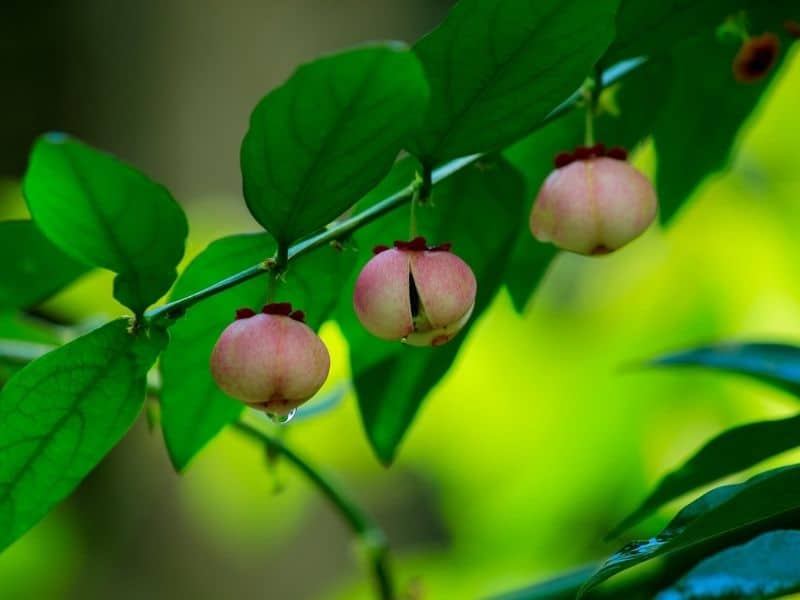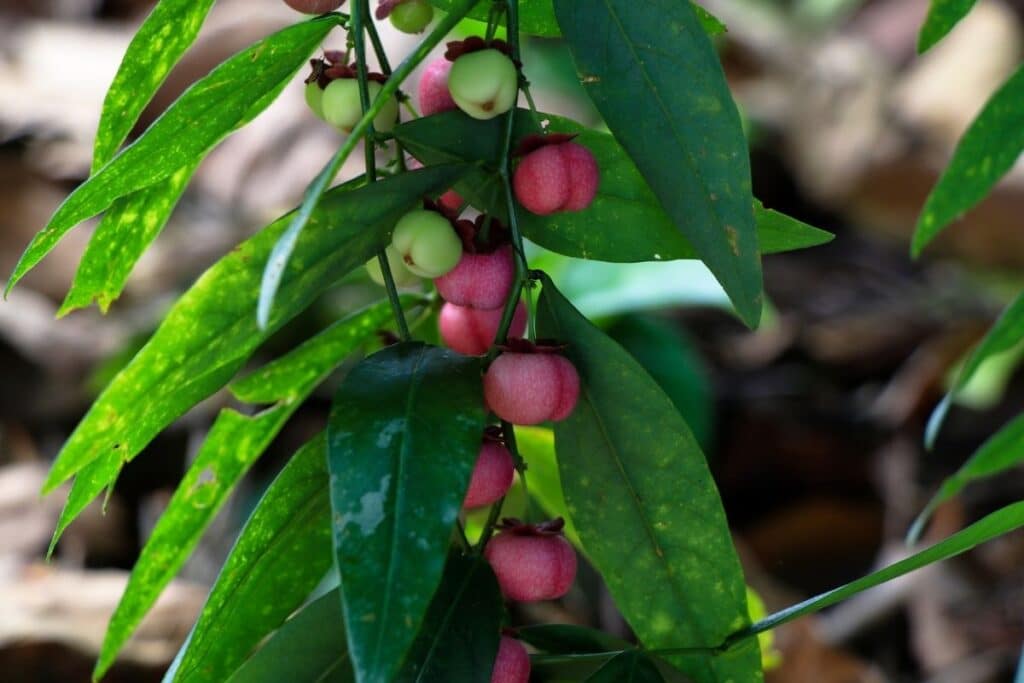Do you live in a tropical area and enjoy growing your own food plants? Katuk is a delicious and nutritious perennial shrub that’s popular in many dishes. This plant is easy to grow and care for and might be the perfect choice for your garden.
What is Katuk?
Katuk is a perennial evergreen shrub that is native to southern and southeast Asia and has been recorded from northern Australia. This plant generally grows to a height of 3- 10 feet (1-3m), or larger in ideal growing conditions, where its growth rate is fast in the growing season, slowing in the cooler months.
Katuk (Sauropus androgynus/ Breynia androgyna) is also commonly known as the star gooseberry or sweet leaf in English. The plant has many other common names including the multivitamin plant, chekup manis, chekkurmenis and changkok manis. Unsurprisingly, manis translates to sweet in English, a reference to the flavor of this edible plant.
This is a tropical species that occurs at lower altitudes of 300-1200ft (100-400m) in forest edge habitats and on slopes. (1)
The dark green leaves of katuk are alternately arranged and variable in size, generally between 1-4 inches(3-10cm) long and 0.75 to 1.5 inch (1.5-3.5cm) wide. (1)
This is an important food and medicinal plant and is cultivated commercially in countries such as the Philippines, Malaysia, India, Vietnam and Thailand.

Katuk Flowers
Each individual Katuk plant produces both male and female flowers and is therefore said to be monoecious. The small flowers are red or red and yellow in color and male and female flowers appear quite different.
These mildly fragrant flowers occur on an axillary inflorescence. That is, along the stems on short stalks from the bases of leaves. The female flowers, which usually occur singly, are produced first, and then followed by numerous male flowers.
White to pink fruits are produced, opening to reveal attractive black and white seeds. Interestingly, both the flowers and fruits of this plant are edible.
How To Grow Katuk
Katuk can be grown from seed or cuttings. Seed can be quite slow to germinate but Katuk cuttings of 6-8 inches(15-20cm) take well. Katuk grows well as a hedge if seedlings or cuttings are planted close together and well fertilized.
This plant can be grown in a variety of soil types, including clay, loam and sand, but prefers a well-drained soil with a slightly acidic to neutral pH of 6-7. A general potting mix will work just fine for this plant.
Katuk does well in partial shade, especially the kind of dappled light of a forest understory, but can be grown in full sun provided it is kept well watered.
In cooler areas, this plant will be dormant, or go through a period of limited growth, in the non-growing season, and can be cut back quite heavily to stimulate regrowth in the spring.
In such cool areas, the sweet leaf bush can be grown in containers, which can be overwintered indoors or in a greenhouse to avoid damage from cold weather.
These tropical plants are adapted to high rainfall conditions and can be grown in USDA zones 10 to 12 and down to Uk zone 10.
Care And Maintenance
This is a low maintenance species. These edible plants are very tolerant of pruning and can be maintained as a hedge or be pruned right down in the cold season.
If you’re growing your katuk for consumption, and harvesting regularly, this plant will appreciate regular fertilizing and a rich compost to maintain good yields.
Although this plant is somewhat tolerant of dry conditions, it does appreciate regular watering and a moist soil, particularly when grown in full sun and tropical climates.
Uses
Gardening Uses
While not a particularly showy plant, Katuk makes a great addition to an edible garden and has the added benefits of being suitable for use as a screen or hedge. Its ability to thrive in partial shade makes it suitable for growing under larger trees.
This plant creates a tropical atmosphere in the garden and a variegated variety has an interesting gray-green foliage color.
Food Uses
Katuk is most popularly used as a leaf vegetable and is consumed throughout south and southeastern Asia. The plant has high protein, vitamin A and vitamin C content.
The plant’s vitamin B content is considered to be far higher than that of most leafy greens and a wide variety of essential minerals are also contained, including sodium, potassium, calcium, phosphorous, iron, magnesium, zinc, manganese and cobalt. (2)
You can eat raw Katuk parts like young leaves and shoots while mature leaves are cooked. This plant can also produce fruit that is edible. The leaves are known to maintain their firmness during cooking and are said to have a mildly nutty, pea-like flavor.
Leaves and shoots of katuk are used in a wide variety of dishes, including salads, stir-fries, soups and more.
Katuk may be harvested throughout the year in tropical regions. This fast-growing species may be harvested at intervals of as little as two months under good growing conditions.
While Katuk plants are considered safe to eat and enjoyed by millions, it should nevertheless be enjoyed in moderation, rather than eaten as a staple. This is because the plant contains a compound known as papaverine, which is believed to have caused a condition known as Bronchiolitis obliterans in patients who ingested large amounts of the plant over a long period of time.
It is also advised that cooked katuk is safer than raw. (2)
Medicinal Uses
Katuk is also widely used in Asia as a medicinal plant for a wide variety of conditions, such as cardiovascular conditions, skin conditions to improve eyesight, and to assist in weight-loss, although its effectiveness has not been fully studied. [2]
FAQs
Is katuk safe to eat?
Yes, eating katuk is considered safe, but should not be eaten excessively. Individuals who consumed very high amounts of this plant (as well as an extract of the plant) for a sustained period were reported to develop a serious lung condition. Cooked katuk is also thought to be safer for consumption than the raw product.
Can Katuk leaves be eaten raw?
Yes, Katuk leaves can be eaten raw. They have a mild, nutty flavor and are often used in salads or as a garnish. However, cooking them is also a common practice and can enhance their taste and nutritional value.
Does Katuk like shade?
Yes, Katuk (Sauropus androgynus) is known to thrive in partial shade. It generally prefers a well-drained soil with partial sunlight, making it suitable for cultivation in areas with filtered or dappled sunlight. However, some exposure to sunlight is still important for healthy growth.
Conclusion
Katuk is an excellent plant for tropical gardens, especially for those who enjoy producing their own food. It’s true that there are more colorful and showy plants available, but the combination of edibility, usefulness in landscaping and attractiveness make this a really great choice.
For more interesting shrub, check our evergreen shrub list.
References
Reference list
(1) eFloras (2008). Published on the Internet http://www.efloras.org [accessed 31 December 2020]*’ Missouri Botanical Garden, St. Louis, MO & Harvard University Herbaria, Cambridge, MA.
(2) Khoo, H., E. & Azlan, A. Sauropus Androgynus Leaves For Health Benefits: Hype And The Science.
Close
*image by JBShots/depositphotos







